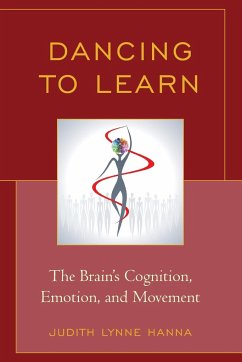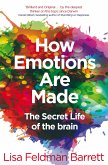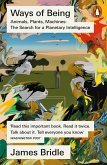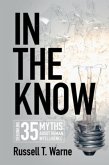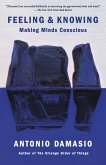- Broschiertes Buch
- Merkliste
- Auf die Merkliste
- Bewerten Bewerten
- Teilen
- Produkt teilen
- Produkterinnerung
- Produkterinnerung
Dancing to Learn: Cognition, Emotion, and Movement explores the rationale for dance as a medium of learning to help engage educators and scientists to explore the underpinnings of dance, and dancers as well as members of the general public who are curious about new ways of comprehending dance.
Andere Kunden interessierten sich auch für
![Role of Industry Academia Interface in Skill Development Role of Industry Academia Interface in Skill Development]() Role of Industry Academia Interface in Skill Development180,99 €
Role of Industry Academia Interface in Skill Development180,99 €![Future Tense Future Tense]() Tracy Dennis-TiwaryFuture Tense18,99 €
Tracy Dennis-TiwaryFuture Tense18,99 €![How Emotions Are Made How Emotions Are Made]() Lisa Feldman BarrettHow Emotions Are Made9,49 €
Lisa Feldman BarrettHow Emotions Are Made9,49 €![Ways of Being Ways of Being]() James BridleWays of Being11,49 €
James BridleWays of Being11,49 €![In the Know In the Know]() Russell T. WarneIn the Know17,99 €
Russell T. WarneIn the Know17,99 €![Feeling & Knowing Feeling & Knowing]() Antonio DamasioFeeling & Knowing11,99 €
Antonio DamasioFeeling & Knowing11,99 €![Happiness Happiness]() Tim LomasHappiness12,99 €
Tim LomasHappiness12,99 €-
-
-
Dancing to Learn: Cognition, Emotion, and Movement explores the rationale for dance as a medium of learning to help engage educators and scientists to explore the underpinnings of dance, and dancers as well as members of the general public who are curious about new ways of comprehending dance.
Hinweis: Dieser Artikel kann nur an eine deutsche Lieferadresse ausgeliefert werden.
Hinweis: Dieser Artikel kann nur an eine deutsche Lieferadresse ausgeliefert werden.
Produktdetails
- Produktdetails
- Verlag: Rowman & Littlefield Publishers
- Seitenzahl: 230
- Erscheinungstermin: 17. November 2014
- Englisch
- Abmessung: 234mm x 156mm x 13mm
- Gewicht: 357g
- ISBN-13: 9781475806052
- ISBN-10: 1475806051
- Artikelnr.: 41250526
- Herstellerkennzeichnung
- Libri GmbH
- Europaallee 1
- 36244 Bad Hersfeld
- gpsr@libri.de
- Verlag: Rowman & Littlefield Publishers
- Seitenzahl: 230
- Erscheinungstermin: 17. November 2014
- Englisch
- Abmessung: 234mm x 156mm x 13mm
- Gewicht: 357g
- ISBN-13: 9781475806052
- ISBN-10: 1475806051
- Artikelnr.: 41250526
- Herstellerkennzeichnung
- Libri GmbH
- Europaallee 1
- 36244 Bad Hersfeld
- gpsr@libri.de
Judith Hanna earned a Ph.D. in anthropology from Columbia University, an M.A. in political science from Michigan State University, and a B.A. in political science from UCLA. She is an Affiliate Senior Research Scientist in the Department of Anthropology at the University of Maryland, an educator, writer and dance critic.
Contents Acknowledgments Prelude: To Dance Is Cognitive, Emotional, and
Moving What Do We Know about Dance? Triangulating Knowledge Brain
Scientists Study Dancers and Spectators Disclosure Steps toward
Understanding Dance as a Learning Medium Chapter 1. The Brain
"Choreographs" Dance-Maker, Dancer, and Spectator Cross-Cultural
Conceptualization of Dance The Body in Space, Time, and With Effort
Transformation of Everyday Movements for Expressive Purpose Culture The
Moving Body Aids Human Evolution Dancing Nourishes a Ravenous Brain
Architecture of the Brain Neurons - Atoms of Thinking Sparking -
Neurogenesis Dance Embodies Cognition Senses, Interoception, and Perception
Vision, an Especially Important Sense Mirror Neurons Mind and Consciousness
Memory Dance in Mind, Space, Pace, and Aging Verbal and Nonverbal (Dance)
Languages of Thought Comparison of Languages Many Languages and Dialects of
Dance Thinking through Language Multilingualism in Dance Feeling and
Emotion Stress Recollection/ Reconsolidation of Emotion Motivation and the
Pleasure of Dance Encore Chapter 2. The Mentality and Matter of Learning
through Dance The Brain Sustains Dance Languages Powerful Hand
Communication More Body Parts, More Powerful Dance Declarative, Procedural,
and Social Knowledge for Dance Music and Dance Together Packing and
Unpacking Meaning in Dance Symbolization Dancing a Science Dissertation
Dimensions of Meaning in Dance (Probing with a Semantic Grid) Dance in the
Moment and Memory Visual Images and Mindfulness Perception of Emotion
Thinking through Memorable Images of Dance Dance Sparks Brain Networks and
Learning for Old and Young Dance Lowers Risks for Brain Deterioration
Performing Arts in General Acquisition of Learning Skills through Dance
Creativity Challenges Prompting Creativity Encore Chapter 3. Brain-Changing
Dance Venues: From Street/Studio/Classroom to Stage and Back
Multi-linguistic Dance: Plethora of Genres Many Ways of Learning Dance
Academic Schools Pre-School Dance Dance as a Discipline Pre-professional
Dance Dance Company Schools and Outreach Programs Arts Magnet Schools
Program within a School New York City Public Schools Cluster School Program
A County-Wide Multifaceted Program in all Public Schools Dance Integration
- with Other Arts or Non-Arts Disciplines Elementary School High School
University Dance Education Performing Arts Organization Offerings John F.
Kennedy Center for the Performing Arts Lincoln Center Institute for the
Arts in Education Washington Performing Arts Society Young Audiences
National Dance Institute (NDI) ArtsConnection Young Talent Dance Program/
English Language Literacy Program Community Based Dance Programs Dance
Teacher Preparation Private Dance Studios and Conservatories Dance
Education Lab Pulse Ontario (Canada) Dance Education Conference National
Registry of Dance Educators State Dance Certification In-service Workshops
National Dance Education Organization Encore Chapter 4. The Dancing Brain
Leaves No One Behind A Performing Art A Liberal Art An Applied Art Personal
Development through Dance Aids Learning Dance Engages and Motivates Dance
and Changing Behavior Dance Integrated with Other Subjects Assessing
Non-dance Learning through Dance Children's Own Dance as a Diagnostic Tool
Transfer of Dance Learning Dimensions of Transfer Brain Action Teaching for
Transfer Research on Transfer Tools for Dance Learning Media, Cyberspace,
and Social Networks Distance Learning "Pen and Paper" Movement Analysis
Dance Curriculum, Standards, Assessment, and Evaluation Dance to Cope with
Stress Bad Stress - Distress Good Stress - Eustress Dance a Stressor Escape
Encore Chapter 5. Mind and Emotion in Learning Self, Cultural and National
Identities through Dance Dancer Identity, Career, Transitions, and
Dance-related Options Gender and Sexual Orientation Who Is On-stage?
Females Males in Dance Culture, Diversity, Understanding, and Choreographic
Inspiration Black/White Interaction Regional or National Identity Applying
Cultural Diversity Selecting Dances Cultural Appropriation Playing
Anthropologist to Learn about a Culture's Dance Encore Finale and Révérence
Dance - Cinderella of Education and Brain Science Plié: Ready to Soar in
Brain and Body Figure 1. Elements of Dance Figure 2. Ways of Conveying
Meaning in Dance (Semantic Grid) Appendix 1: Tools to Discover the Dancing
Brain Appendix 2: To Dance in a Classroom, Even for Non-Dancers Images and
Credits References Cited About the Brain Teaching Dance Index About the
Author
Moving What Do We Know about Dance? Triangulating Knowledge Brain
Scientists Study Dancers and Spectators Disclosure Steps toward
Understanding Dance as a Learning Medium Chapter 1. The Brain
"Choreographs" Dance-Maker, Dancer, and Spectator Cross-Cultural
Conceptualization of Dance The Body in Space, Time, and With Effort
Transformation of Everyday Movements for Expressive Purpose Culture The
Moving Body Aids Human Evolution Dancing Nourishes a Ravenous Brain
Architecture of the Brain Neurons - Atoms of Thinking Sparking -
Neurogenesis Dance Embodies Cognition Senses, Interoception, and Perception
Vision, an Especially Important Sense Mirror Neurons Mind and Consciousness
Memory Dance in Mind, Space, Pace, and Aging Verbal and Nonverbal (Dance)
Languages of Thought Comparison of Languages Many Languages and Dialects of
Dance Thinking through Language Multilingualism in Dance Feeling and
Emotion Stress Recollection/ Reconsolidation of Emotion Motivation and the
Pleasure of Dance Encore Chapter 2. The Mentality and Matter of Learning
through Dance The Brain Sustains Dance Languages Powerful Hand
Communication More Body Parts, More Powerful Dance Declarative, Procedural,
and Social Knowledge for Dance Music and Dance Together Packing and
Unpacking Meaning in Dance Symbolization Dancing a Science Dissertation
Dimensions of Meaning in Dance (Probing with a Semantic Grid) Dance in the
Moment and Memory Visual Images and Mindfulness Perception of Emotion
Thinking through Memorable Images of Dance Dance Sparks Brain Networks and
Learning for Old and Young Dance Lowers Risks for Brain Deterioration
Performing Arts in General Acquisition of Learning Skills through Dance
Creativity Challenges Prompting Creativity Encore Chapter 3. Brain-Changing
Dance Venues: From Street/Studio/Classroom to Stage and Back
Multi-linguistic Dance: Plethora of Genres Many Ways of Learning Dance
Academic Schools Pre-School Dance Dance as a Discipline Pre-professional
Dance Dance Company Schools and Outreach Programs Arts Magnet Schools
Program within a School New York City Public Schools Cluster School Program
A County-Wide Multifaceted Program in all Public Schools Dance Integration
- with Other Arts or Non-Arts Disciplines Elementary School High School
University Dance Education Performing Arts Organization Offerings John F.
Kennedy Center for the Performing Arts Lincoln Center Institute for the
Arts in Education Washington Performing Arts Society Young Audiences
National Dance Institute (NDI) ArtsConnection Young Talent Dance Program/
English Language Literacy Program Community Based Dance Programs Dance
Teacher Preparation Private Dance Studios and Conservatories Dance
Education Lab Pulse Ontario (Canada) Dance Education Conference National
Registry of Dance Educators State Dance Certification In-service Workshops
National Dance Education Organization Encore Chapter 4. The Dancing Brain
Leaves No One Behind A Performing Art A Liberal Art An Applied Art Personal
Development through Dance Aids Learning Dance Engages and Motivates Dance
and Changing Behavior Dance Integrated with Other Subjects Assessing
Non-dance Learning through Dance Children's Own Dance as a Diagnostic Tool
Transfer of Dance Learning Dimensions of Transfer Brain Action Teaching for
Transfer Research on Transfer Tools for Dance Learning Media, Cyberspace,
and Social Networks Distance Learning "Pen and Paper" Movement Analysis
Dance Curriculum, Standards, Assessment, and Evaluation Dance to Cope with
Stress Bad Stress - Distress Good Stress - Eustress Dance a Stressor Escape
Encore Chapter 5. Mind and Emotion in Learning Self, Cultural and National
Identities through Dance Dancer Identity, Career, Transitions, and
Dance-related Options Gender and Sexual Orientation Who Is On-stage?
Females Males in Dance Culture, Diversity, Understanding, and Choreographic
Inspiration Black/White Interaction Regional or National Identity Applying
Cultural Diversity Selecting Dances Cultural Appropriation Playing
Anthropologist to Learn about a Culture's Dance Encore Finale and Révérence
Dance - Cinderella of Education and Brain Science Plié: Ready to Soar in
Brain and Body Figure 1. Elements of Dance Figure 2. Ways of Conveying
Meaning in Dance (Semantic Grid) Appendix 1: Tools to Discover the Dancing
Brain Appendix 2: To Dance in a Classroom, Even for Non-Dancers Images and
Credits References Cited About the Brain Teaching Dance Index About the
Author
Contents Acknowledgments Prelude: To Dance Is Cognitive, Emotional, and
Moving What Do We Know about Dance? Triangulating Knowledge Brain
Scientists Study Dancers and Spectators Disclosure Steps toward
Understanding Dance as a Learning Medium Chapter 1. The Brain
"Choreographs" Dance-Maker, Dancer, and Spectator Cross-Cultural
Conceptualization of Dance The Body in Space, Time, and With Effort
Transformation of Everyday Movements for Expressive Purpose Culture The
Moving Body Aids Human Evolution Dancing Nourishes a Ravenous Brain
Architecture of the Brain Neurons - Atoms of Thinking Sparking -
Neurogenesis Dance Embodies Cognition Senses, Interoception, and Perception
Vision, an Especially Important Sense Mirror Neurons Mind and Consciousness
Memory Dance in Mind, Space, Pace, and Aging Verbal and Nonverbal (Dance)
Languages of Thought Comparison of Languages Many Languages and Dialects of
Dance Thinking through Language Multilingualism in Dance Feeling and
Emotion Stress Recollection/ Reconsolidation of Emotion Motivation and the
Pleasure of Dance Encore Chapter 2. The Mentality and Matter of Learning
through Dance The Brain Sustains Dance Languages Powerful Hand
Communication More Body Parts, More Powerful Dance Declarative, Procedural,
and Social Knowledge for Dance Music and Dance Together Packing and
Unpacking Meaning in Dance Symbolization Dancing a Science Dissertation
Dimensions of Meaning in Dance (Probing with a Semantic Grid) Dance in the
Moment and Memory Visual Images and Mindfulness Perception of Emotion
Thinking through Memorable Images of Dance Dance Sparks Brain Networks and
Learning for Old and Young Dance Lowers Risks for Brain Deterioration
Performing Arts in General Acquisition of Learning Skills through Dance
Creativity Challenges Prompting Creativity Encore Chapter 3. Brain-Changing
Dance Venues: From Street/Studio/Classroom to Stage and Back
Multi-linguistic Dance: Plethora of Genres Many Ways of Learning Dance
Academic Schools Pre-School Dance Dance as a Discipline Pre-professional
Dance Dance Company Schools and Outreach Programs Arts Magnet Schools
Program within a School New York City Public Schools Cluster School Program
A County-Wide Multifaceted Program in all Public Schools Dance Integration
- with Other Arts or Non-Arts Disciplines Elementary School High School
University Dance Education Performing Arts Organization Offerings John F.
Kennedy Center for the Performing Arts Lincoln Center Institute for the
Arts in Education Washington Performing Arts Society Young Audiences
National Dance Institute (NDI) ArtsConnection Young Talent Dance Program/
English Language Literacy Program Community Based Dance Programs Dance
Teacher Preparation Private Dance Studios and Conservatories Dance
Education Lab Pulse Ontario (Canada) Dance Education Conference National
Registry of Dance Educators State Dance Certification In-service Workshops
National Dance Education Organization Encore Chapter 4. The Dancing Brain
Leaves No One Behind A Performing Art A Liberal Art An Applied Art Personal
Development through Dance Aids Learning Dance Engages and Motivates Dance
and Changing Behavior Dance Integrated with Other Subjects Assessing
Non-dance Learning through Dance Children's Own Dance as a Diagnostic Tool
Transfer of Dance Learning Dimensions of Transfer Brain Action Teaching for
Transfer Research on Transfer Tools for Dance Learning Media, Cyberspace,
and Social Networks Distance Learning "Pen and Paper" Movement Analysis
Dance Curriculum, Standards, Assessment, and Evaluation Dance to Cope with
Stress Bad Stress - Distress Good Stress - Eustress Dance a Stressor Escape
Encore Chapter 5. Mind and Emotion in Learning Self, Cultural and National
Identities through Dance Dancer Identity, Career, Transitions, and
Dance-related Options Gender and Sexual Orientation Who Is On-stage?
Females Males in Dance Culture, Diversity, Understanding, and Choreographic
Inspiration Black/White Interaction Regional or National Identity Applying
Cultural Diversity Selecting Dances Cultural Appropriation Playing
Anthropologist to Learn about a Culture's Dance Encore Finale and Révérence
Dance - Cinderella of Education and Brain Science Plié: Ready to Soar in
Brain and Body Figure 1. Elements of Dance Figure 2. Ways of Conveying
Meaning in Dance (Semantic Grid) Appendix 1: Tools to Discover the Dancing
Brain Appendix 2: To Dance in a Classroom, Even for Non-Dancers Images and
Credits References Cited About the Brain Teaching Dance Index About the
Author
Moving What Do We Know about Dance? Triangulating Knowledge Brain
Scientists Study Dancers and Spectators Disclosure Steps toward
Understanding Dance as a Learning Medium Chapter 1. The Brain
"Choreographs" Dance-Maker, Dancer, and Spectator Cross-Cultural
Conceptualization of Dance The Body in Space, Time, and With Effort
Transformation of Everyday Movements for Expressive Purpose Culture The
Moving Body Aids Human Evolution Dancing Nourishes a Ravenous Brain
Architecture of the Brain Neurons - Atoms of Thinking Sparking -
Neurogenesis Dance Embodies Cognition Senses, Interoception, and Perception
Vision, an Especially Important Sense Mirror Neurons Mind and Consciousness
Memory Dance in Mind, Space, Pace, and Aging Verbal and Nonverbal (Dance)
Languages of Thought Comparison of Languages Many Languages and Dialects of
Dance Thinking through Language Multilingualism in Dance Feeling and
Emotion Stress Recollection/ Reconsolidation of Emotion Motivation and the
Pleasure of Dance Encore Chapter 2. The Mentality and Matter of Learning
through Dance The Brain Sustains Dance Languages Powerful Hand
Communication More Body Parts, More Powerful Dance Declarative, Procedural,
and Social Knowledge for Dance Music and Dance Together Packing and
Unpacking Meaning in Dance Symbolization Dancing a Science Dissertation
Dimensions of Meaning in Dance (Probing with a Semantic Grid) Dance in the
Moment and Memory Visual Images and Mindfulness Perception of Emotion
Thinking through Memorable Images of Dance Dance Sparks Brain Networks and
Learning for Old and Young Dance Lowers Risks for Brain Deterioration
Performing Arts in General Acquisition of Learning Skills through Dance
Creativity Challenges Prompting Creativity Encore Chapter 3. Brain-Changing
Dance Venues: From Street/Studio/Classroom to Stage and Back
Multi-linguistic Dance: Plethora of Genres Many Ways of Learning Dance
Academic Schools Pre-School Dance Dance as a Discipline Pre-professional
Dance Dance Company Schools and Outreach Programs Arts Magnet Schools
Program within a School New York City Public Schools Cluster School Program
A County-Wide Multifaceted Program in all Public Schools Dance Integration
- with Other Arts or Non-Arts Disciplines Elementary School High School
University Dance Education Performing Arts Organization Offerings John F.
Kennedy Center for the Performing Arts Lincoln Center Institute for the
Arts in Education Washington Performing Arts Society Young Audiences
National Dance Institute (NDI) ArtsConnection Young Talent Dance Program/
English Language Literacy Program Community Based Dance Programs Dance
Teacher Preparation Private Dance Studios and Conservatories Dance
Education Lab Pulse Ontario (Canada) Dance Education Conference National
Registry of Dance Educators State Dance Certification In-service Workshops
National Dance Education Organization Encore Chapter 4. The Dancing Brain
Leaves No One Behind A Performing Art A Liberal Art An Applied Art Personal
Development through Dance Aids Learning Dance Engages and Motivates Dance
and Changing Behavior Dance Integrated with Other Subjects Assessing
Non-dance Learning through Dance Children's Own Dance as a Diagnostic Tool
Transfer of Dance Learning Dimensions of Transfer Brain Action Teaching for
Transfer Research on Transfer Tools for Dance Learning Media, Cyberspace,
and Social Networks Distance Learning "Pen and Paper" Movement Analysis
Dance Curriculum, Standards, Assessment, and Evaluation Dance to Cope with
Stress Bad Stress - Distress Good Stress - Eustress Dance a Stressor Escape
Encore Chapter 5. Mind and Emotion in Learning Self, Cultural and National
Identities through Dance Dancer Identity, Career, Transitions, and
Dance-related Options Gender and Sexual Orientation Who Is On-stage?
Females Males in Dance Culture, Diversity, Understanding, and Choreographic
Inspiration Black/White Interaction Regional or National Identity Applying
Cultural Diversity Selecting Dances Cultural Appropriation Playing
Anthropologist to Learn about a Culture's Dance Encore Finale and Révérence
Dance - Cinderella of Education and Brain Science Plié: Ready to Soar in
Brain and Body Figure 1. Elements of Dance Figure 2. Ways of Conveying
Meaning in Dance (Semantic Grid) Appendix 1: Tools to Discover the Dancing
Brain Appendix 2: To Dance in a Classroom, Even for Non-Dancers Images and
Credits References Cited About the Brain Teaching Dance Index About the
Author

